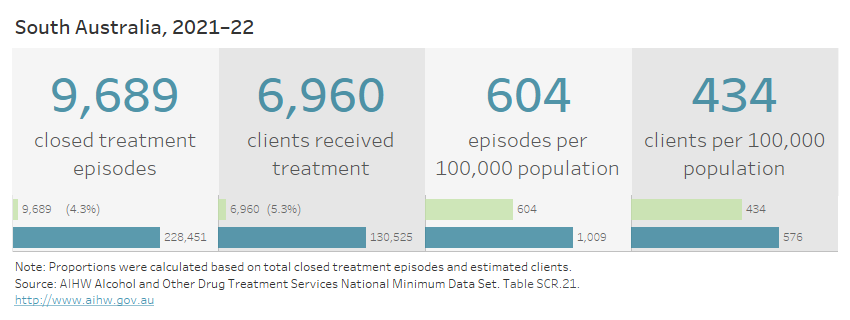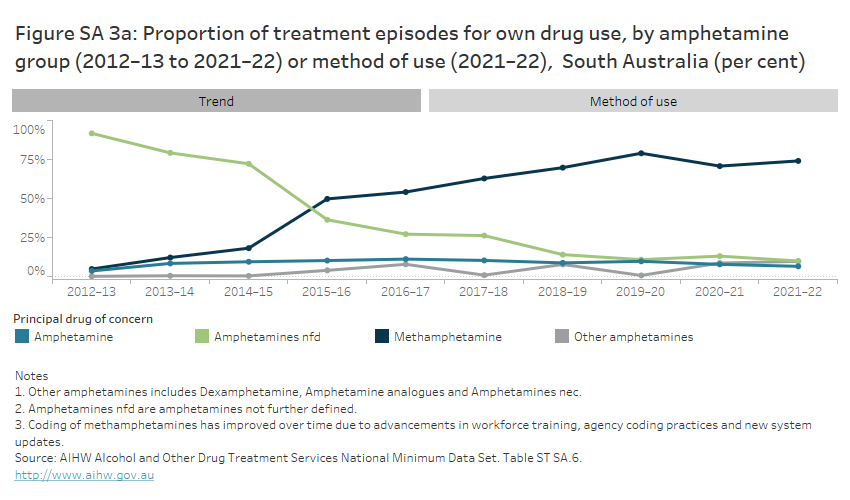South Australia
On this page:
In 2021–22, 83 publicly funded alcohol and other drug treatment agencies in South Australia provided 9,689 treatment episodes to just 6,960 clients (tables Agcy.1, SCR.21).
South Australia reported:
- a decrease in treatment episodes since 2013–14, falling from 13,200 to 9,799 episodes in 2021–22 (Table ST SA.2)
- fewer clients are using AOD services in 2021–22 than 2013–14, after adjusting for population growth (434 clients per 100,000 population compared with 624 per 100,000, respectively)
- client numbers decreased from 9,200 in 2013–14 to 7,000 in 2021–22 (Table SCR.21).
The visualisation shows that 9,689 treatment episodes were provided to 6,960 clients in South Australia in 2021–22. This equates to a rate of 604 episodes and 434 clients per 100,000 population, lower than the national rate (1,009 episodes and 576 clients per 100,000 population).

In 2021–22, most (86%) clients in South Australia attended 1 agency, and received an average of 1.4 treatment episodes, which is lower than the national average of 1.8 treatment episodes (tables SCR.21, SCR.23).
Client demographics
In 2021–22:
- nearly all (over 99%) clients in South Australia received treatment for their own alcohol or drug use, of which over 3 in 5 (62%) people were male (Figure SA 1)
- 2 in 3 people seeking treatment for someone else’s alcohol or drug use were female (67%)
- over half (53%) of all people were aged 30–49 years
- over 1 in 6 (18%) people identified as Indigenous Australians, which is consistent with the national proportion (18%)
- the majority (91%) of clients were born in Australia and nearly all (98%) reported English as their preferred language (tables SC SA.1–3, SC.4, SC SA.21–22).
The visualisation includes a series of horizontal bar graphs showing that, in 2021–22 in South Australia, just under two-thirds (62%) of all clients were male, 51% were aged 20–39 and 18% were Indigenous Australians. Nearly all clients (98%) listed English as their preferred language and most (91%) were born in Australia.

Patterns of service use
Over the period 2017–18 to 2021–22, 28,400 clients received treatment in South Australia. Of these clients, the majority of clients received treatment in a single year (76% or 21,700):
- 4,200 (15%) received treatment for the first time in 2021–22
- a further 17,500 (62%) received treatment in only one of the five collection periods (excluding 2021–22) (Table SCR.28).
Drugs of concern
In 2021–22, for clients in South Australia receiving treatment episodes for their own alcohol or drug use:
- alcohol was the most common principal drug of concern for clients (41% or 4,000 episodes) (Figure SA 2)
- amphetamines accounted for one-third of treatment episodes (31% or 2,900), followed by cannabis (15% or 1,500).
The grouped horizontal bar chart shows that, in 2021–22, alcohol was the most common principal drug of concern in treatment episodes provided to clients in South Australia for their own drug use (41.2%). This was followed by amphetamines (30.5%) and cannabis (15.3%). Cannabis was the most common additional drug of concern (19.4% of episodes), followed by amphetamines (9.9%) and alcohol (9.7%).

In 2021–22, for clients receiving treatment for their own use of amphetamines:
- methamphetamine was reported as a principal drug of concern in approximately 74% of treatment episodes (Figure SA 3a)
- where methamphetamine was the principal drug of concern, smoking was the most common method of use in 59% of treatment episodes, followed by injecting (33%) (Figure SA 3b).
The line graph shows that, from 2012–13 to 2014–15, ‘amphetamines not further defined’ was the most common drug of concern among amphetamine-related treatment episodes for clients’ own drug use. In 2015–16, methamphetamine became the most common drug of concern. The proportion of episodes for methamphetamine increased from 4.7% in 2012–13 to 74.1% in 2021–22, while episodes for amphetamines not further defined decreased from 91.8% to 9.9% over the same period. Buttons allow the user to navigate to data on amphetamines by method of use.

Clients can nominate up to 5 additional drugs of concern; these drugs are not necessarily the subject of any treatment within the episode (see technical notes).
In 2021–22, when clients reported additional drugs of concern, nicotine was the most common (22% of episodes), followed by cannabis (19%) (Table ST SA.7).
Over the period 2012–13 to 2021–22:
- alcohol was the most common principal drug of concern over this period, from 38% of episodes in 2012–12, falling to 27% in 2016–17, increasing to 41% in 2021–22 (Table ST SA.7)
- amphetamines have remained the second most common principal drug of concern have increased over this period, from 24% in 2012–13 to 34–37% of episodes between 2016–17 and 2019–20, before falling to 31% in 2021–22. Amphetamine treatment episodes increased over this period from 2,700 in 2012–13, peaking at 4,300 in 2018–19, falling to 3,000 in 2021–22
- for episodes where amphetamines were the principal drug of concern, the proportion of treatment episodes with methamphetamines has increased more than 15-fold since 2012–13 (from 4.7% to 79% in 2019–20, slightly falling to 74% in 2021–22 (Figure SA 3a)
- the rise in episodes may be related to increases in funded treatment services and/or improvement in agency coding practices for methamphetamines.
The proportion of treatment episodes for amphetamines as a principal drug of concern has been consistently higher in South Australia than the national proportion (31% and 24% respectively in 2021–22). This is related to a state government legislated program regarding assessments provided under a Police Drug Diversion initiative. The program results in comparatively high proportions of engagement with methamphetamine users.
In addition, due to the Cannabis Expiation Notice legislation in South Australia, adult simple cannabis offences are not diverted to treatment and so are not included in the data (see the Data Quality Statement).
Treatment
In 2021–22, for treatment episodes in South Australia:
- counselling was the most common main treatment (40% of episodes), followed by assessment only (23%) and withdrawal management (15%) (Figure SA 4, Table ST SA.13)
- where an additional treatment was provided as a supplementary to the main treatment, support and case management (16%) was the most common additional treatment, followed by counselling (9.3%). See technical notes for further information on calculating proportions for additional treatment type.
Over the period 2012–13 to 2021–22:
- counselling as main treatment has doubled in the 10 years to 2021–22 (from 20% of treatment episodes in 2012–13 to 40%)
- the proportion of episodes with rehabilitation as main treatment fell from 8.6% to 2.2%
- the proportion of episodes where assessment only was the main treatment has almost halved since 2012–13, falling from 43% to 23% in 2021–22. However, assessment only in South Australia remained considerably higher than the national proportion (ranging from 16% to 21%) (tables ST SA.13, Trt.4).
The high proportion of treatment episodes where assessment only is the most common treatment type relates in part to the SA Police Drug Diversion Initiative (PDDI).
The grouped horizontal bar chart shows that, in 2021–22, the most common main treatment type provided to clients in South Australia for their own drug use was counselling (39.9% of episodes). This was followed by assessment only (23.1%) and withdrawal management (15.2%). Support and case management was the most common additional treatment type (16.3% of episodes), followed by counselling (9.3%).

Agencies
In 2021–22, in South Australia:
- 3 in 5 (61%) of 83 AOD agencies that received public funding were non-government treatment agencies
- around half (47%) of all treatment agencies were located in Major cities, followed by Outer regional areas (23%) and Inner regional areas (23%) (Figure SA 5, Table Agcy.3)
- In Very Remote areas 2 of 3 treatment agencies (67%) were government organisations.
Over the 10 years to 2021–22, the number of publicly funded treatment agencies in South Australia decreased from 93 to 83 (Table Agcy.1).
The horizontal bar chart shows that most treatment agencies in South Australia were located in Major cities (39 agencies), followed by Outer regional and Inner regional areas (19 agencies each) in 2021–22. 4 agencies were located in Remote areas and 3 agencies were located in Very remote areas. Of the total 83 treatment agencies, 61% (51 agencies) were non-government agencies.



